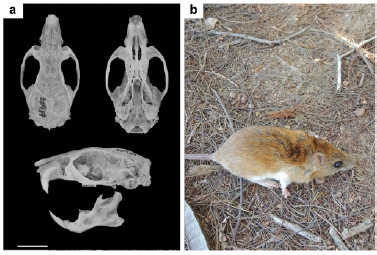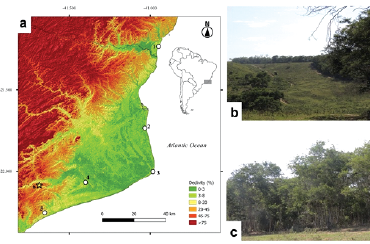The Restinga-Rice-Rat Cerradomys goytacaTavares, Pessôa and Gonçalves, 2011, was recently described based on specimens from four localities in Rio de Janeiro state and one in Espírito Santo state, Brazil (Tavares et al., 2011). All records are in "Restinga" formations, which are composed of plant communities that range from shrubby vegetation to forest, and always associated to sandy coastal plains and dune fields of coastal areas (Tavares et al., 2011; Lemos and Gonçalves, 2015). Thus, C. goytaca is endemic to "Restinga" of the Atlantic Forest of southeastern Brazil and currently classified as "Endangered" (Bonvicino et al., 2018). Data on population dynamics and records from owl pellets were also published - both from Parque Nacional Restinga de Jurubatiba (PNRJ), type locality of C. goytaca (Lemos and Gonçalves, 2015; Lemos et al., 2015). Nonetheless, beside the ones mentioned, any other data is known for the species.
Herein we report a new record for the rare C. goytaca, providing new data on habitat and the sixth record for the species, extending its known distribution to a different phytophisiognomy.
Individuals of C. goytaca were recorded in four out of eight fieldwork expedition (seven days each) from September 2014 to October 2016 in Quissamã, Rio de Janeiro, Brazil (22°05'9.64" S, 41°40'39.61" W). All specimens were captured by live-traps (896 trap-night by expedition) and were released at the local of capture, except by one preserved as skin, skull, and skeleton in the mammal collection of the Museu de Zoologia da Universidade de São Paulo (MZUSP), São Paulo, Brazil. IBAMA license: 482/2014
Seven adult individuals (four males and three females) were captured during fieldwork , all presenting size and pelage characteristics as those described by Tavares et al. (2011): medium body size, with a narrow and long hind feet; dorsal coloration orange grizzled with brown (with relatively short gray-based hairs), darker along the mid line and paler along the sides; head grayish colored (especially around eyes and cheeks) (Fig. 1); gray-based whitish venter; tail longer than head-body length and markedly bicolored. In the preserved specimen (MZUSP 35417) additional features were observed, such as: tail with unpigmented hairs and scales on ventral surface along proximal portion, and uniformly dark above; tail scales large, with modal number 14 per cm near base; tufts of ungual hair over claws, but not exceeding claw length; skull large and robust, with a broad rostrum; developed supraorbital and lambdoidal crests; wide zygomatic arches; deep palatal fossae with complex and broad posteropalatal pits; roof of mesopterygoid fossa with wide and large sphenopalatine vacuities extending broadly along the presphenoid and alisphenoid; alisphenoid strut absent; small posterior opening of the alisphenoid canal; relatively narrow upper molars; poorly developed palatal excrescences; and broad lacrimal, expanded posterolaterally (Fig. 1). The morphometric values of the specimen MZUSP 35417 are shown in Table 1 along with data from literature (Tavares et al., 2011). All characters unambiguously identify the referred specimen as C. goytaca (Tavares et al., 2011; Percequillo, 2015).

Figure 1 Cerradomys goytaca. a - Dorsal, ventral and lateral view of skull and lateral view of the mandible (MZUSP 35417). b - Live specimen from Quissamã, Rio de Janeiro State, Brazil. Brazil. Scale: 10 mm
The new record presented here represents the sixth and the westernmost known locality of C. goytaca (Fig. 2a). All specimens were sampled by live-traps, even though pitfalls traps were also used to capture small mammals in all expeditions. Three out of seven captures occurred in traps placed about 1.0 to 1.5m above the ground, while the other four captures were on ground level, suggesting a scansorial habit for the species.

Figure 2 a - Geographic distribution of Cerradomys goytaca. Literature records (white circles - Tavares et al., 2011): Espírito Santo: 1. Praia das Neves, Presidente Kennedy (21°14' S; 40°57' W). Rio de Janeiro: 2. Restinga de Iquipari-Grussai, Grussai, São João da Barra (21°44'41" S; 41°02'25" w). 3. Restinga do Farolzinho, Farol de São Tomé, Campos dos Goytacazes (22°00' S; 40°59' W). 4. Sitio Santana, Beira de Lagoa, Quissamã (22°04'14" S; 41°24'13" W) 5. Parque Nacional da Restinga de Jurubatiba, Carapebus, (type locality) (22°15' S; 41°39' W). New locality (yellow star): Rio de Janeiro: 6. Quissamã (22°05'9.64" S; 41°40'39.61" W). b and c - View of the Atlantic Forest fragment of capture of C. goytaca in Locality 6. Note the declivity (b), the dense canopy and different strata of the forest fragment (c).
The new locality is in a forested area (Fig. 2b) with a high declivity (red color in Fig. 2a). Previous known records of C. goytaca were in sandy plains near sea level (green color in Fig. 2a; Tavares et al., 2011; Percequillo, 2015). Thus, it is noteworthy that the new record is located on a higher altitude (ca. 60 m.a.s.l.) and declivity (Fig. 2a), within a forest fragment with relatively dense canopy and different strata (Fig. 2c).
Cerradomys goytaca has been considered endemic to the "Restingas", where is abundant in open shrublands and, less frequently, found in arboreal formations (Tavares et al., 2011; Lemos and Gonçalves, 2015). The dominant tree species in such formation is Clusia hilariana (Cluseaceae) (Lemos and Gonçalves, 2015), generally surrounded by bromeliads, tree scrubs, cactus and geophytic palms (Tavares et al., 2011). This type of formation is characteristic of the PNRJ, where C. goytaca is the dominant species (Tavares et al., 2011), but is only the third in abundance at the locality reported herein. Notably the surroundings between the new record and PNRJ (Localities 5 and 6: Fig. 2) are predominantly composed by pasture, and the new record refers to one of the few fragments remaining in the region.
Because of the limited information about C. goytaca population dynamics in the new locality reported here, as well as its presence in other reminiscent forested areas nearby, it is not possible to know whether the presence of the species indicates that C. goytaca occurs extensively in forested phytophysiognomies of the region or if it has occupied the site as a result of anthropogenic pressure on other natural areas. Nonetheless, the new record extends the range distribution, as well as the declivity and altitude used by C. goytaca, and presents new data on the phytophysiognomies where the species might be found, comprising very important information on this poorly known and endangered species.
Table 1 Sex, external and craniodental measurements (mm), and weights (g) of adult specimens of Cerradomys goytaca. Measurements were based on Tavares et al. (2011).
| Parameters | MZUSP 35417 | Tavares et al. (2011)N=23 | |
|---|---|---|---|
| Mean ± SD | Range (Min-Max) | ||
| Sex | Male | Males and females | Males and females |
| Length of head and body | 154 | 142.90 ±13.27 | 116-166 |
| Length of tail | 169 | 162.74 ± 12.64 | 130-181 |
| Ear | 19.60 | 21 ± 1.20 | 19-24 |
| Length of hindfoot with claw | 32.80 | 32.04 ± 1.36 | 30-34 |
| Weight | 117 | 98.01 ± 18.78 | 54-130 |
| Condyle-incisive length | 35.12 | 34.44 ± 1.32 | 32.31-37.18 |
| Length of diastema | 10.51 | 10.55 ± 0.54 | 9.85-11.82 |
| Crown length of the upper molar series | 4.94 | 5.10 ± 0.28 | 4.79-6.29 |
| Breadth of first upper molar | 1.42 | 1.44 ± 0.07 | 1.29-1.65 |
| Length of the incisive foramina | 7.76 | 7.57 ± 0.40 | 7.03-8.70 |
| Palatal breadth | 6.01 | 6.25 ± 0.29 | 5.79-6.93 |
| Breadth of rostrum | 7.79 | 7.42 ± 0.38 | 6.75-8.10 |
| Length of nasal | 13.15 | 14.18 ±0.66 | 13.14-15.31 |
| Length of palatal bridge | 5.96 | 6.15 ± 0.27 | 5.66-6.74 |
| height of braincase | 10.82 | 9.98 ± 0.45 | 9.20-11.17 |
| Least interorbital breadth | 6.33 | 6.39 ± 0.37 | 5.88-7.20 |
| Breadth across the squamosal zygomatic processes | 19.41 | 18.83 ± 0.81 | 17.27-20.44 |
| Condylo-zygomatic length | 26.85 | 27.41 ± 1.15 | 25.43-29.31 |
| Orbital fossa length | 12.90 | 12.88 ±0.46 | 12.03-13.84 |
| Bullar breadth | 5.62 | 5.31 ± 0.16 | 4.95-5.58 |















